|
All reef tank water starts from the tap. And it is rare that tap water is good enough quality for a reef tank. My house had a deep artesian well so chlorine was not an issue. However, the water does have lots of other oddities such as Nitrates, Phosphates, and other heavy metals. Reverse Osmosis water system is key. An RO unit has various stages where each stage is a form of filtration. Such as foam or mesh mechanical filters, activated carbon filters (chemical filtration) then the RO membrane. The RO membrane is expensive part of the filter. Water under pressure is forced against the membrane. Small particles pass, larger ones are rejected as waste. The pressure of your water system, temperature of the water, quality of the source water, and quality of the RO membrane all effect how much waste water will be produced. I had a 5 stage RO unit that makes excellent drinking water. (A Culligan water system is a simplistic 3 stage RO unit usually at 100 times the price). The draw back with RO units is that waste water is produced. A typical unit running under ideal conditions creates 4 to 5 gallons of waste water for each gallon of good RO water. The waste water is just dumped down the drain--however you can use the waste water for freshwater fish tanks, washing laundry, etc. Even though it is called waste water it is still cleaner than tap water as it was passed over several filters. Waste water may not be an issue for a small tank. For example, my 55 gallon tank only needed about 1 gallon a day to make up evaporated water. And I needed 5 gallons a to make a 10% water change. However with the 180 gallon tank I'll needed close to 750 gallons of tap water to fill the tank with decent RO/DI water (Assumed normal 4:1 rejection ratio). My deep well would have gone dry if I tried that to quickly. In addition I need 4 to 5 gallons of RO/DI water a day for evaporation plus about 40 gallons a month to make a 20% water change. My deep well can not sustain that amount of water being used, I needed to come up with something else. |
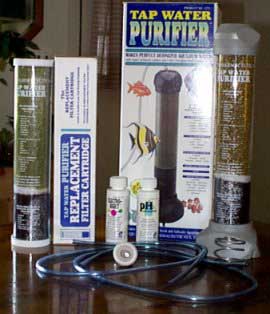
Tap Water Purifier System (right)
Refill Cartridge (left) I tried to skip the RO unit and process water with just a Deionization Unit. DI units are nice in that they do not have any waste water. However, they are more expensive to run. The DI resins that chemically absorb molecules from water are inexpensive but not cheap. To the left you can see the "Tap Water Purifier" (TWP) made by Aquarium Systems. This unit should cost under $30 mail order and the refill cartridge should cost under $20 mail order. Each cartridge is rated to produce 50 to 300 gallons of pure water before needing to be replaced. The 50 gallons target is common don't expect to reach the 300 gallon mark. I was only about to get about 30 gallons from each cartridge. The water produced by a DI unit is purer than RO water. It is claimed that you should not drink this water and this water can not even be used for freshwater tanks (you need to add back some elements). However for saltwater use this is ideal. The salt mix itself provides everything you need. The less dissolved stuff in your source water the better. |
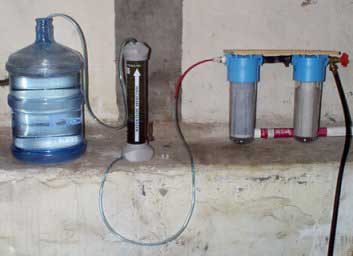
5 Gallon Water Bottle (left), TWP (middle),
Pre-filters (right) To the left you can see my failed attempt at trying to extend the life of the TWP filters. I thought passing it through some fine Carbon Block filters would extend the life of these filters. No such luck; made no detectable difference. I thought I would get into manually recharging these resins but I never found the time to work with dangerous chemicals. I had to go back to using my RO water system. Luckily I had other family members with a decent RO water system and I had them fill up four 5 gallon water bottles each week for me. That helped with water changes, and I use my RO/DI system to cover the 4 to 5 gallons a day I need to replace evaporated water. Sadly, that person passed away. I lost a significant source of water. |
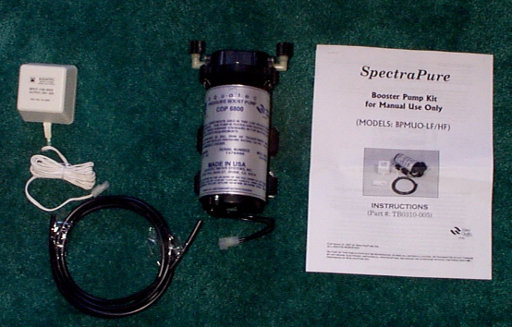
SpectraPure RO Booster Pump
One way to reduce the amount of waste water is to increase the pressure the system operates at. My RO system with new filters operates at 35psi (my house with deep well water pressure). This is too low. Plus as the filters age and get clogged the PSI drops. To the left you can see the SpectraPure water booster pump I use to raise my water pressure to the RO unit to about 85 to 95 PSI. Making a gallon of RO/DI water using a 25 GPD (Gallons Per Day) membrane used to take several hours now takes 45 minutes to an hour for this unit (matches the rated GPD). |
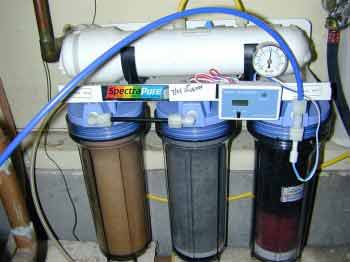
SpectraPure 4 Stage 60GPD RO/DI unit
I upgraded to a SpectraPure 60 Gallon Per Day RO/DI Unit that I installed at my in-laws since they have a very strong deep well. This unit has a Pressure gauge to show current PSI level, a flush valve (top of unit - blue valve with yellow tubing) and I replaced the standard Spectrapure Conductivity Monitor with a AquaFX Dual TDS monitor.
|
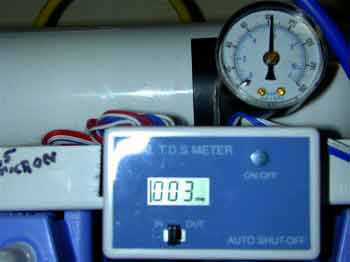
AquaFX Dual TDS Meter
Picture left is a closeup of the AquaFX Dual TDS meter. TDS is an acronym for Total Dissolved Solids. This unit is a dual unit in that it has two sensors -- one attached to the output of the RO membrane and the other on the output of the DI cartridge. I just flip a lever to select which one to display a reading for. The picture shows the water coming out of the RO membrane at 3ppm which is excellent. I can use the DTS meter to calculate my RO membranes rejection ratio. You should replace your RO membrane every 2 years or if your membrane rejection rate falls below 98%. My tap water has about 320ppm TDS. The RO membrane is removing 317ppm (since only 3ppm getting past). That is over a 99% rejection rate. At my current tap water TDS level, I would change the RO membrane when TDS meter shows 10 to 12ppm getting by. The TDS meter shows the output of the DI cartridge to be 0ppm (not pictured). I would change the DI cartridge when it reads about 2ppm. |
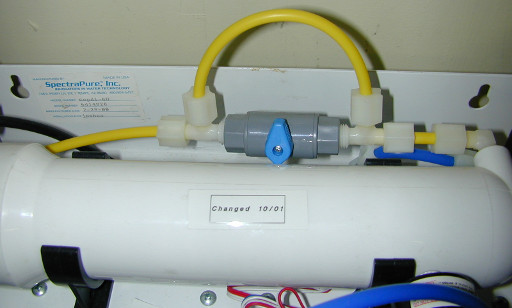
SpectraPure Ro Flush Valve Kit
This is the flush valve. It is attached to the waste line of the RO membrane. The primary purpose of the flush valve is to bypass the flow restrictor within the waste line. The flow restrictor is in the curved part of the yellow tube and water is squeezed into the flow restrictor by the house water pressure and booster pump. (The flow restrictor is just a very narrow tube inside the waster line and it's length determines the amount of waste water that will be produced). When opened the valve bypasses the flow restrictor and allows water to enter the RO membrane at full force and flush out many of the impurities that have built up in the membrane. I open the valve for about 1 minutes before and after I make water. |

SpectraPure RO 60GPD RO Membrane
Once I have my source water ready (either from TWP or RO/DI unit). I move the water into two 30 gallon Rubbermaid tubs. I add a 250w heater to each one to bring the water up to about 78 degrees F. I also keep a powerhead in each tub to keep the water moving and to help with gas exchange. Usually the following day I add the salt, but you really do not need to wait so long. I use Instant Ocean brand salt. This *is* the best brand to use. I tried Reef Crystal Brand and saw no significant difference, not worth the extra expense. Most experts and public aquariums use Instant Ocean. I've read several on-line questionnaires completed by fellow hobbyist and Instant Ocean and Reef Crystals were the top 2 rated salts. Instant Ocean brand matches Natural Sea Water the closest of all major brands (that I know of). I'm sure your thinking this is a sales pitch - it's not. I have nothing to do with the makers of this fine synthetic sea salt. Water in your tanks should be kept at 35 ppt (parts per thousands) or a specific gravity of 1.025 at 82 degrees. I adjust the salt batch to match this as necessary testing with a Hand Held Optical Refractometer. I give the new saltwater water about 24 to 48 hours to mature (not really needed). I use a MaxiJet 1000 powerhead to pump about 50 gallons of water out of the system. That water gets dump down the drian. I then use the Maxijet 1000 to pump the new water into the tank. |
